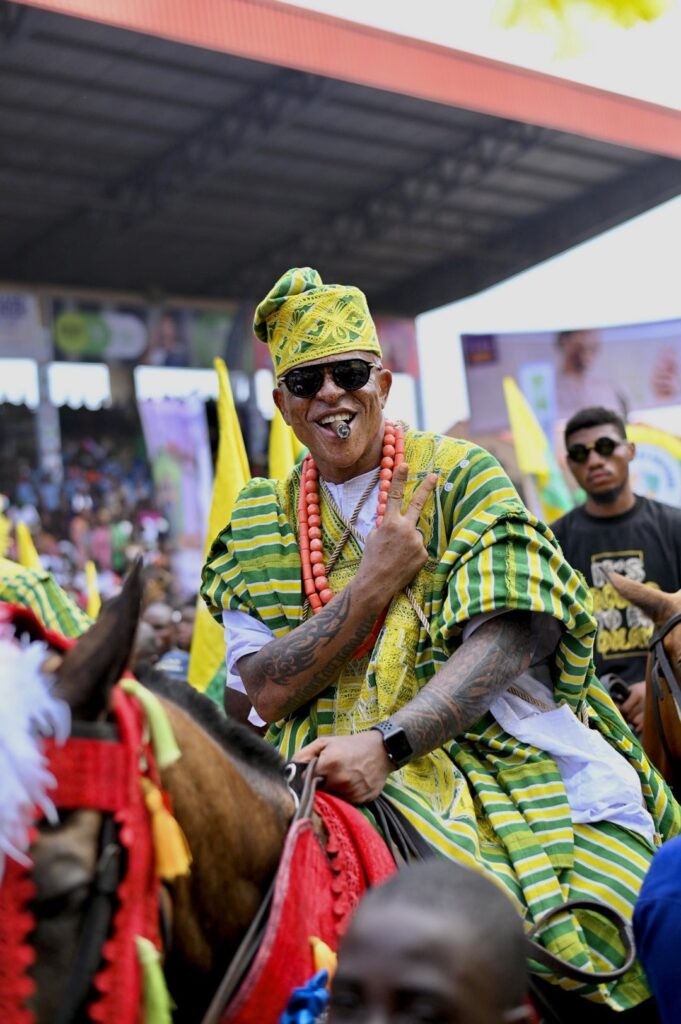
In the 19th century, disputes over trade led to strain between Benin and its chief trading partner, Great Britain. This escalated as the European powers moved to divide Africa into colonial territories.
The situation culminated in 1897, when a large delegation led by Britain’s Acting Consul-General in the region, James Phillips, set off for Benin City despite requests from Oba Ovonramwen to postpone their visit.
On January 12, an Edo force ambushed the British delegation. Almost the entire party was killed, including Phillips. In quick order, a large British military force—deemed the Punitive Expedition— was assembled, and on February 18, they arrived in Benin City under orders to invade and conquer it. In time they captured Oba Ovonramwen and sent him into exile to Calabar, a town east of Benin.
On February 18, 1897, British imperialists invaded and conquered the Benin Kingdom, in spite of its defensive iya. The city was set ablaze, although it has been claimed that this was accidental.
Immediately after the city was captured, widespread looting began. It was an exercise that was carried out by all members of the expedition.
Houses, sacred sites, ceremonial buildings and palaces of many high-ranking chiefs were looted and many buildings were burned down, including the Palace building itself on Sunday, February 21, 1897.
With these events, the daily routines of the royal court were disrupted and the Edo people were severed from their leaders. Objects within the royal palaces were now the spoils of war, many of which were sold to defray the costs of the invasion. Others were shared among members of the expeditionary force. Still others left Benin in the confusion that followed the devastation of the kingdom.
Most of the plunder from the city was retained by the expedition with some 2,500 (official figures) religious artefacts, Benin visual history, mnemonics and artworks being sent to Britain. They include over a thousand metal plaques and sculptures collectively known as the Benin Bronzes. The Admiralty confiscated and auctioned off the war booty to defray the costs of the expedition.

Upon their arrival in London, Benin’s royal arts were a topic of conversation and speculation. They sparked immediate interest from museums, particularly in Britain and the German-speaking world, which made efforts to purchase the objects for their collections. Eventually works from Benin could be found in museums across Europe and the United States.
About 40 per cent of the art was accessioned to the British Museum, while other works were given to individual members of the armed forces as spoils of war, and the remainder was sold at auction by the Admiralty to pay for the expedition as early as May 1897 (Stevens Auction Rooms, 38 King Street, London, May 25, 1897; followed by several sales at William Downing Webster, Bicester, between 1898 and 1900).
Forged in one of the best furnaces around, ‘Okpa’, or cockerel, was the peak of the artistic tradition of the Benin Empire. The work has traversed centuries and has survived the test of time. Though the name of its creator remains anonymous, the story of ‘Okpa’ or ‘Okukor’, as it is popularly known, is still relevant to date.
In 2017, a cockerel statue or ‘Okukor’ looted during the 1897 Benin Expedition was removed from the hall of Jesus College, Cambridge, following protests by students of the university.
Jesus College’s student union passed a motion declaring that the sculpture should be returned. A spokesperson from the university stated: t “Jesus College acknowledges the contribution made by students in raising the important but complex question of the rightful location of its Benin bronze, in response to which it has removed the ‘Okukor’ from its hall” and that the university is willing “to discuss and determine the best future for the ‘Okukor’, including the question of repatriation.”
On October 27, 2021, the National Commission for Museums and Monuments (NCMM) received the Okukor in a Benin Bronze Restitution Ceremony held and live-streamed by Jesus College.
Delegates from Nigeria and Benin participated in a ceremony to mark the handover and celebrate the Bronze’s rightful return. Prince Aghatise Erediauwa, younger brother of the Oba of Benin, Omo N’Oba N’Edo Uku Akpolokpolo, Ewuare II, commended Jesus College for challenging the argument that stolen art cannot be returned and expressed gratitude to the student body and the Legacy of Slavery Working Party for their efforts. Ms. Sonita Alleyne OBE, Master of Jesus College, described the occasion as momentous and expressed her thanks to all those who had worked towards it.
The Chair of the LSWP, Dr. Véronique Mottier, expressed mixed emotions at the Bronze’s return, thrilled to see it going back to its rightful owners but also painfully aware of the historic wrong committed by keeping it away for so long.
A statement in Benin by the Secretary to the Benin Traditional Council (BTC), Mr Frank Erhabor, said the physical handing over of the artefacts was a sequel to the directive of President Muhammadu Buhari to the Nigerian High Commissioner to personally hand them over to the Benin monarch.
It would be recalled that on December 13, 2021, a document on the return of the artefacts was signed by the Oba of Benin, some of his chiefs and the Nigerian High Commissioner to Britain in accordance with British law.
While there has been a success in repatriating a few of the artefacts home, some are yet to return, as they continue to adorn foreign museums. However, the struggle of bringing them back home doesn’t change history or its ancestral route. Nigeria is blessed with rich cultures and rich people who understand its craft.



